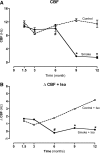Long-term cigarette smoke exposure in a mouse model of ciliated epithelial cell function
- PMID: 20042711
- PMCID: PMC2993085
- DOI: 10.1165/rcmb.2009-0297OC
Long-term cigarette smoke exposure in a mouse model of ciliated epithelial cell function
Abstract
Exposure to cigarette smoke is associated with airway epithelial mucus cell hyperplasia and a decrease in cilia and ciliated cells. Few models have addressed the long-term effects of chronic cigarette smoke exposure on ciliated epithelial cells. Our previous in vitro studies showed that cigarette smoke decreases ciliary beat frequency (CBF) via the activation of protein kinase C (PKC). We hypothesized that chronic cigarette smoke exposure in an in vivo model would decrease airway epithelial cell ciliary beating in a PKC-dependent manner. We exposed C57BL/6 mice to whole-body cigarette smoke 2 hours/day, 5 days/week for up to 1 year. Tracheal epithelial cell CBF and the number of motile cells were measured after necropsy in cut tracheal rings, using high-speed digital video microscopy. Tracheal epithelial PKC was assayed according to direct kinase activity. At 6 weeks and 3 months of smoke exposure, the baseline CBF was slightly elevated (~1 Hz) versus control mice, with no change in β-agonist-stimulated CBF between control mice and cigarette smoke-exposed mice. By 6 months of smoke exposure, the baseline CBF was significantly decreased (2-3 Hz) versus control mice, and a β-agonist failed to stimulate increased CBF. The loss of β-agonist-increased CBF continued at 9 months and 12 months of smoke exposure, and the baseline CBF was significantly decreased to less than one third of the control rate. In addition to CBF, ciliated cell numbers significantly decreased in response to smoke over time, with a significant loss of tracheal ciliated cells occurring between 6 and 12 months. In parallel with the slowing of CBF, significant PKC activation from cytosol to the membrane of tracheal epithelial cells was detected in mice exposed to smoke for 6-12 months.
Figures





Similar articles
-
Co-exposure to cigarette smoke and alcohol decreases airway epithelial cell cilia beating in a protein kinase Cε-dependent manner.Am J Pathol. 2012 Aug;181(2):431-40. doi: 10.1016/j.ajpath.2012.04.022. Epub 2012 Jun 5. Am J Pathol. 2012. PMID: 22677421 Free PMC article.
-
Effects of cigarette smoke and alcohol on ciliated tracheal epithelium and inflammatory cell recruitment.Am J Respir Cell Mol Biol. 2007 Apr;36(4):452-9. doi: 10.1165/rcmb.2005-0440OC. Epub 2006 Nov 1. Am J Respir Cell Mol Biol. 2007. PMID: 17079783 Free PMC article.
-
Desensitization of PKA-stimulated ciliary beat frequency in an ethanol-fed rat model of cigarette smoke exposure.Alcohol Clin Exp Res. 2004 Jul;28(7):998-1004. doi: 10.1097/01.alc.0000130805.75641.f4. Alcohol Clin Exp Res. 2004. PMID: 15252285 Free PMC article.
-
Roflumilast N-oxide, a PDE4 inhibitor, improves cilia motility and ciliated human bronchial epithelial cells compromised by cigarette smoke in vitro.Br J Pharmacol. 2012 Aug;166(8):2243-62. doi: 10.1111/j.1476-5381.2012.01929.x. Br J Pharmacol. 2012. PMID: 22385203 Free PMC article.
-
Intracellular Cl- Regulation of Ciliary Beating in Ciliated Human Nasal Epithelial Cells: Frequency and Distance of Ciliary Beating Observed by High-Speed Video Microscopy.Int J Mol Sci. 2020 Jun 5;21(11):4052. doi: 10.3390/ijms21114052. Int J Mol Sci. 2020. PMID: 32517062 Free PMC article. Review.
Cited by
-
Barrier function of airway tract epithelium.Tissue Barriers. 2013 Oct 1;1(4):e24997. doi: 10.4161/tisb.24997. Epub 2013 May 30. Tissue Barriers. 2013. PMID: 24665407 Free PMC article. Review.
-
CRACking the Beat of Cilia: Calcium Rocks.Am J Respir Cell Mol Biol. 2019 Oct;61(4):410-411. doi: 10.1165/rcmb.2019-0072ED. Am J Respir Cell Mol Biol. 2019. PMID: 30990760 Free PMC article. No abstract available.
-
Cigarette smoking decreases macrophage-dependent clearance to impact the biological effects of occupational and environmental particle exposures.Front Public Health. 2025 Apr 9;13:1558723. doi: 10.3389/fpubh.2025.1558723. eCollection 2025. Front Public Health. 2025. PMID: 40270740 Free PMC article. Review.
-
Respiratory Viral and Bacterial Exacerbations of COPD-The Role of the Airway Epithelium.Cells. 2022 Apr 22;11(9):1416. doi: 10.3390/cells11091416. Cells. 2022. PMID: 35563722 Free PMC article. Review.
-
FOXJ1 prevents cilia growth inhibition by cigarette smoke in human airway epithelium in vitro.Am J Respir Cell Mol Biol. 2014 Nov;51(5):688-700. doi: 10.1165/rcmb.2013-0363OC. Am J Respir Cell Mol Biol. 2014. PMID: 24828273 Free PMC article.
References
-
- Trofor A, Frasila EI. The habit of smoking—a sure step towards COPD. Pneumologia 2007;56:85–90. - PubMed
-
- Proctor RN. The global smoking epidemic: a history and status report. Clin Lung Cancer 2004;5:371–376. - PubMed
-
- Vastag E, Matthys H, Kohler D, Gronbeck L, Daikeler G. The connections between smoking, mucociliary clearance and airway obstruction. Fortschr Med 1984;102:629–634. - PubMed
-
- Cohen D, Arai SF, Brain JD. Smoking impairs long-term dust clearance from the lung. Science 1979;204:514–517. - PubMed
-
- Sisson S, Tripp J, Paris W, Cooper DK, Zuhdi N. Medication noncompliance and its relationship to financial factors after heart transplantation. J Heart Lung Transplant 1994;13:930. - PubMed
Publication types
MeSH terms
Substances
Grants and funding
LinkOut - more resources
Full Text Sources

